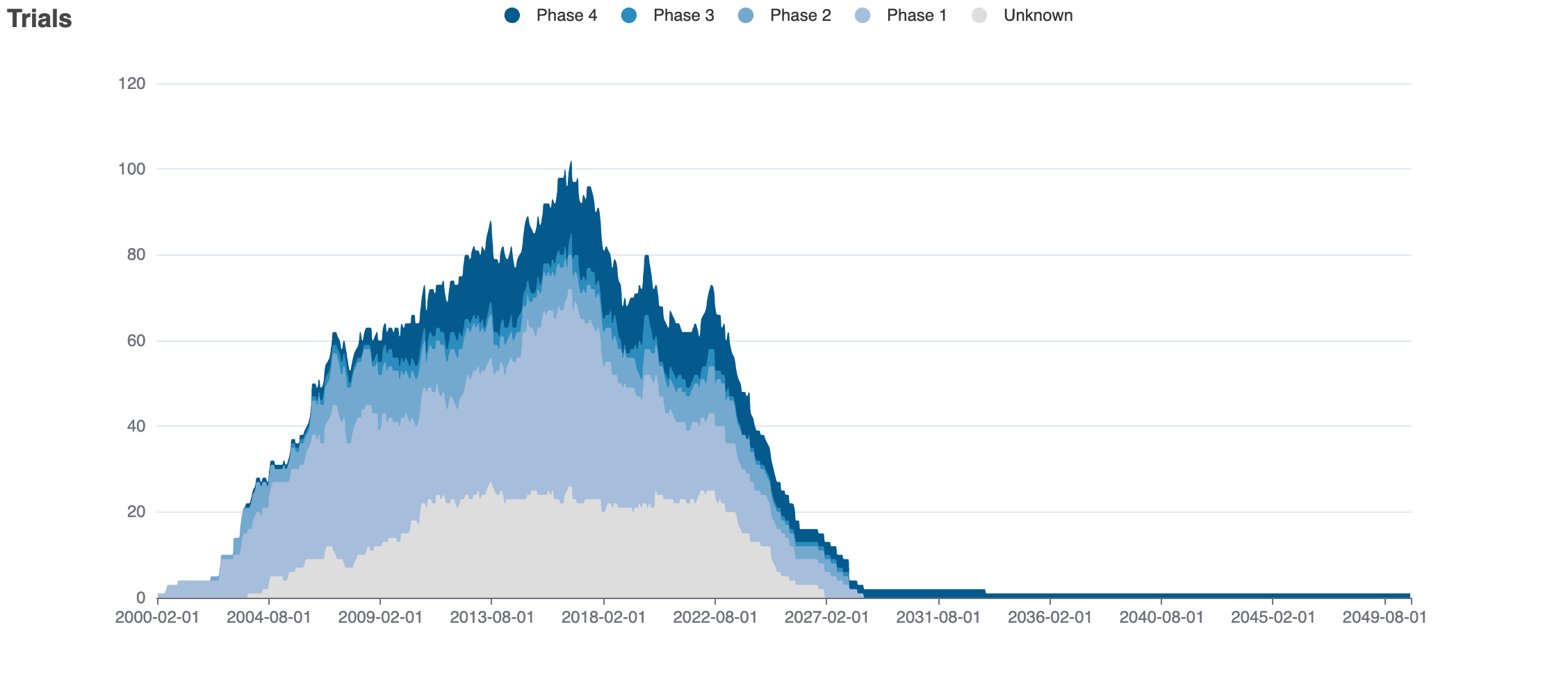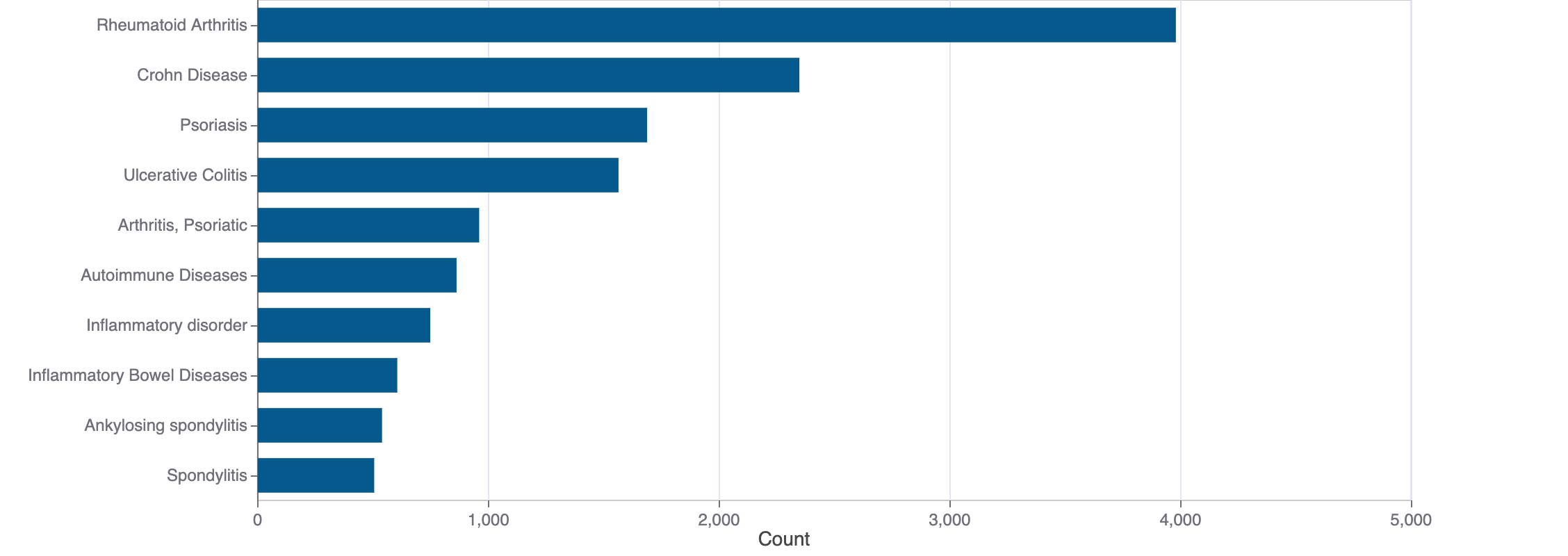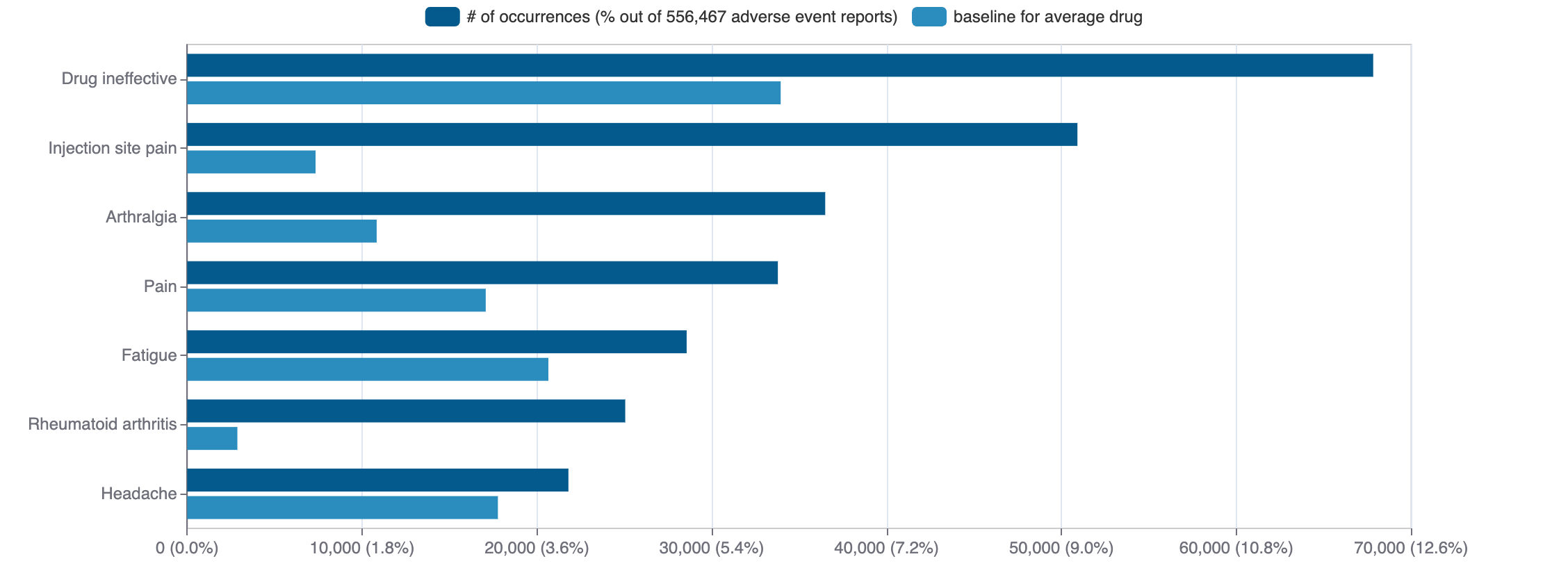Oxaprozin
Daypro (oxaprozin) is a small molecule pharmaceutical. Oxaprozin was first approved as Daypro on 1992-10-29. It is used to treat juvenile arthritis, osteoarthritis, and rheumatoid arthritis in the USA. The pharmaceutical is active against prostaglandin G/H synthase 2 and prostaglandin G/H synthase 1. In addition, it is known to target bifunctional epoxide hydrolase 2.
Download report
Favorite
Commercial
Trade Name
FDA
EMA
Daypro (generic drugs available since 2001-01-31, discontinued: Daypro alta)
Drug Products
FDA
EMA
New Drug Application (NDA)
New Drug Application (NDA)
Abbreviated New Drug Application (ANDA)
Abbreviated New Drug Application (ANDA)
Indications
FDA
EMA
Indication | Ontology | MeSH | ICD-10 |
|---|---|---|---|
| juvenile arthritis | EFO_0002609 | D001171 | M08 |
| osteoarthritis | EFO_0002506 | D010003 | M15-M19 |
| rheumatoid arthritis | EFO_0000685 | D001172 | M06.9 |
Agency Specific
FDA
EMA
No data
Patent Expiration
No data
HCPCS
No data
Clinical
Clinical Trials
354 clinical trials
View more details

Mock data
Subscribe for the real data
Subscribe for the real data
Indications Phases 4
Indication | MeSH | Ontology | ICD-10 | Ph 1 | Ph 2 | Ph 3 | Ph 4 | Other | Total |
|---|---|---|---|---|---|---|---|---|---|
| Vomiting | D014839 | HP_0002013 | R11.1 | 7 | 18 | 25 | 20 | 12 | 81 |
| Postoperative nausea and vomiting | D020250 | EFO_0004888 | 5 | 8 | 7 | 23 | 15 | 56 | |
| Nausea | D009325 | HP_0002018 | R11.0 | 11 | 10 | 7 | 16 | 4 | 46 |
| Neoplasms | D009369 | C80 | 1 | 2 | 7 | 1 | 4 | 15 | |
| Alcoholism | D000437 | EFO_0003829 | F10.1 | 1 | 9 | 4 | 1 | — | 14 |
| Gastroenteritis | D005759 | EFO_1001463 | K52.9 | 1 | 1 | 5 | 4 | 3 | 13 |
| Postoperative pain | D010149 | G89.18 | 1 | 1 | — | 5 | 5 | 12 | |
| Hypotension | D007022 | EFO_0005251 | I95 | — | 1 | 5 | 4 | 2 | 11 |
| Breast neoplasms | D001943 | EFO_0003869 | C50 | — | 4 | 2 | 1 | 2 | 8 |
| Anesthesia | D000758 | — | — | 3 | 1 | 2 | 6 |
Show 39 more
Indications Phases 3
Indication | MeSH | Ontology | ICD-10 | Ph 1 | Ph 2 | Ph 3 | Ph 4 | Other | Total |
|---|---|---|---|---|---|---|---|---|---|
| Schizophrenia | D012559 | EFO_0000692 | F20 | 2 | 1 | 2 | — | 1 | 6 |
| Myeloid leukemia acute | D015470 | C92.0 | — | 3 | 1 | — | — | 4 | |
| Myelodysplastic syndromes | D009190 | D46 | — | 2 | 1 | — | 1 | 4 | |
| Lymphoma | D008223 | C85.9 | — | — | 1 | — | 2 | 3 | |
| Leukemia | D007938 | C95 | — | — | 1 | — | 1 | 2 | |
| Myeloproliferative disorders | D009196 | D47.1 | — | — | 1 | — | 1 | 2 | |
| Plasma cell neoplasms | D054219 | — | — | 1 | — | 1 | 2 | ||
| General anesthesia | D000768 | — | — | 2 | — | — | 2 | ||
| Laparoscopy | D010535 | — | — | 2 | — | — | 2 | ||
| Postoperative complications | D011183 | — | — | 2 | — | — | 2 |
Show 14 more
Indications Phases 2
Indication | MeSH | Ontology | ICD-10 | Ph 1 | Ph 2 | Ph 3 | Ph 4 | Other | Total |
|---|---|---|---|---|---|---|---|---|---|
| Cocaine-related disorders | D019970 | F14 | — | 2 | — | — | 2 | 4 | |
| Non-hodgkin lymphoma | D008228 | C85.9 | 1 | 2 | — | — | — | 3 | |
| Glioma | D005910 | EFO_0000520 | — | 2 | — | — | — | 2 | |
| Bcr-abl positive chronic myelogenous leukemia | D015464 | EFO_0000340 | — | 2 | — | — | — | 2 | |
| Multiple myeloma | D009101 | C90.0 | 1 | 1 | — | — | — | 2 | |
| Pancreatic neoplasms | D010190 | EFO_0003860 | C25 | — | 1 | — | — | 1 | 2 |
| Hyperemesis gravidarum | D006939 | EFO_1000971 | O21 | — | 2 | — | — | — | 2 |
| Neuralgia | D009437 | EFO_0009430 | 2 | 1 | — | — | — | 2 | |
| Psychotic disorders | D011618 | F20.81 | 1 | 1 | — | — | — | 2 | |
| Hematologic diseases | D006402 | EFO_0005803 | D75.9 | — | 1 | — | — | — | 1 |
Show 36 more
Indications Phases 1
Indication | MeSH | Ontology | ICD-10 | Ph 1 | Ph 2 | Ph 3 | Ph 4 | Other | Total |
|---|---|---|---|---|---|---|---|---|---|
| Healthy volunteers/patients | — | 16 | — | — | — | 2 | 18 | ||
| Post-concussion syndrome | D038223 | EFO_1001827 | F07.81 | 1 | — | — | — | — | 1 |
| Dyspnea | D004417 | HP_0002094 | R06.0 | 1 | — | — | — | — | 1 |
| Traumatic brain injuries | D000070642 | S06 | 1 | — | — | — | — | 1 | |
| Brain concussion | D001924 | S06.0 | 1 | — | — | — | — | 1 | |
| Percutaneous nephrolithotomy | D000074642 | 1 | — | — | — | — | 1 | ||
| Emergence delirium | D000071257 | 1 | — | — | — | — | 1 |
Indications Without Phase
Indication | MeSH | Ontology | ICD-10 | Ph 1 | Ph 2 | Ph 3 | Ph 4 | Other | Total |
|---|---|---|---|---|---|---|---|---|---|
| Inguinal hernia | D006552 | HP_0000023 | K40 | — | — | — | — | 2 | 2 |
| Male breast neoplasms | D018567 | — | — | — | — | 2 | 2 | ||
| Genetic polymorphism | D011110 | — | — | — | — | 1 | 1 | ||
| Lymphoproliferative disorders | D008232 | Orphanet_2442 | D47.9 | — | — | — | — | 1 | 1 |
| Aortic valve disease | D000082862 | — | — | — | — | 1 | 1 | ||
| Coronary artery disease | D003324 | I25.1 | — | — | — | — | 1 | 1 | |
| Rhytidoplasty | D015361 | — | — | — | — | 1 | 1 | ||
| Microvascular decompression surgery | D061145 | — | — | — | — | 1 | 1 | ||
| Cryptorchidism | D003456 | EFO_0004562 | Q53.1 | — | — | — | — | 1 | 1 |
| Deglutition disorders | D003680 | HP_0002015 | R13.1 | — | — | — | — | 1 | 1 |
Show 15 more
Epidemiology
Epidemiological information for investigational and approved indications
View more details
Drug
General
| Drug common name | OXAPROZIN |
| INN | oxaprozin |
| Description | Oxaprozin is a monocarboxylic acid that is a propionic acid derivative having a 4,5-diphenyl-1,3-oxazol-2-yl substituent at position 3. It is non-steroidal anti-inflammatory drug commonly used to relieve the pain and inflammatory responses associated with osteoarthritis and rheumatoid arthritis. It has a role as a non-steroidal anti-inflammatory drug and an analgesic. It is a member of 1,3-oxazoles and a monocarboxylic acid. It is functionally related to a propionic acid. |
| Classification | Small molecule |
| Drug class | — |
| Image (chem structure or protein) | |
| Structure (InChI/SMILES or Protein Sequence) | O=C(O)CCc1nc(-c2ccccc2)c(-c2ccccc2)o1 |
Identifiers
| PDB | 7XC4 |
| CAS-ID | 21256-18-8 |
| RxCUI | 32613 |
| ChEMBL ID | CHEMBL1071 |
| ChEBI ID | 7822 |
| PubChem CID | 4614 |
| DrugBank | DB00991 |
| UNII ID | MHJ80W9LRB (ChemIDplus, GSRS) |
Target
Agency Approved
PTGS2
PTGS2
PTGS1
PTGS1
Organism
Homo sapiens
Gene name
PTGS2
Gene synonyms
COX2
NCBI Gene ID
Protein name
prostaglandin G/H synthase 2
Protein synonyms
COX-2, cyclooxygenase 2, cyclooxygenase 2b, Cyclooxygenase-2, PGH synthase 2, PGHS-2, PHS II, Prostaglandin H2 synthase 2, Prostaglandin-endoperoxide synthase 2, prostaglandin-endoperoxide synthase 2 (prostaglandin G/H synthase and cyclooxygenase)
Uniprot ID
Mouse ortholog
Ptgs2 (19225)
prostaglandin G/H synthase 2 (Q543K3)
Alternate
EPHX2
EPHX2
Organism
Homo sapiens
Gene name
EPHX2
Gene synonyms
NCBI Gene ID
Protein name
bifunctional epoxide hydrolase 2
Protein synonyms
epoxide hydratase, epoxide hydrolase 2, cytoplasmic, epoxide hydrolase 2, cytosolic, epoxide hydrolase, soluble
Uniprot ID
Mouse ortholog
Ephx2 (13850)
bifunctional epoxide hydrolase 2 (P34914)
Variants
Clinical Variant
No data
Financial
No data
Trends
PubMed Central
Top Terms for Disease or Syndrome:

Mock data
Subscribe for the real data
Subscribe for the real data
Additional graphs summarizing 465 documents
View more details
Safety
Black-box Warning
Black-box warning for: Daypro, Oxaprozin
Adverse Events
Top Adverse Reactions

Mock data
Subscribe for the real data
Subscribe for the real data
19,733 adverse events reported
View more details
Premium feature
Learn more about premium features at pharmakb.com
Learn more
